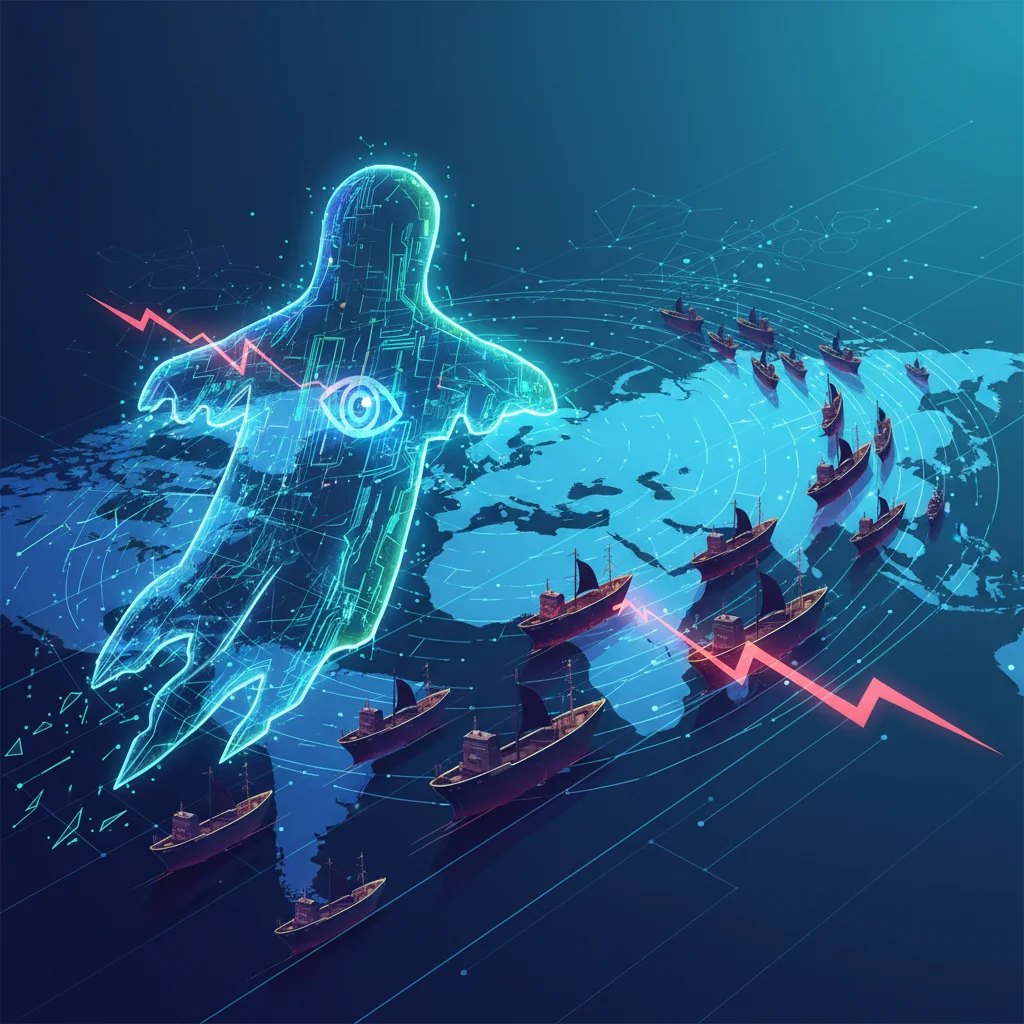
The Ghost in the Machine: How AI and Cybersecurity are Hunting Russia’s Shadow Fleet
The High-Seas Game of Cat and Mouse
Imagine a fleet of ghost ships, hundreds strong, silently gliding through the world’s most critical waterways. They carry millions of barrels of oil, but they don’t officially exist. They have no valid flag, their tracking systems are often dark, and their ownership is a labyrinth of shell corporations. This isn’t a pirate movie; it’s the reality of Russia’s “shadow fleet,” a sophisticated operation designed to bust international sanctions. As detailed in a recent BBC report, this growing network of vessels poses a massive challenge to European authorities.
But while the headlines focus on the geopolitics, for those of us in the tech world—developers, entrepreneurs, and cybersecurity professionals—this story reveals something far more fascinating. This is not just a maritime problem; it’s one of the most complex, high-stakes data and cybersecurity challenges on the planet. The battle against the shadow fleet isn’t being fought with patrol boats alone. It’s being waged with algorithms, petabytes of data, and cutting-edge artificial intelligence.
This is a story about how code is being deployed to unravel a global conspiracy, how machine learning models are predicting illicit activity from faint signals in the noise, and how the principles of digital threat hunting are being applied to the vast, physical world of the open ocean.
Deconstructing the Deception: Shadow Fleet Tactics as a Cyber Threat Model
To understand the solution, we first need to appreciate the ingenuity of the problem. The operators of this fleet employ a range of tactics that will sound eerily familiar to any cybersecurity expert. They are, in essence, running a massive obfuscation campaign.
- Going Dark (The DDoS Attack): The most common tactic is simply turning off the Automatic Identification System (AIS) transponder. AIS is the GPS-based system that lets ships “see” each other and be seen by authorities. Disabling it is like a server dropping off the network to hide its activity. In dense shipping lanes like the English Channel, this is incredibly dangerous, but it’s a risk they’re willing to take (source).
- ID Spoofing (The Phishing Campaign): Some ships engage in “spoofing,” where they manipulate their AIS data to broadcast a false identity, location, or destination. It’s the maritime equivalent of an email phishing attack, where the vessel pretends to be something it’s not to evade detection and gain illegitimate access to ports or passages.
- Flag Hopping (The Shell Corporation): Vessels in the shadow fleet frequently change their registered flag—the country under which they are documented—to jurisdictions with lax oversight. This is a classic money-laundering technique, creating a confusing paper trail that makes it nearly impossible to determine ultimate ownership and hold anyone accountable.
- Obscure Ownership (The Anonymous Proxy): The ships are often owned by a complex web of single-purpose shell companies in various jurisdictions, making the true beneficiary of the oil sales a moving target. This is akin to routing malicious traffic through a chain of anonymous proxies to hide the origin of an attack.
When you map these tactics to their digital equivalents, the path forward becomes clear. You can’t fight a sophisticated network of proxies and spoofed identities with a simple blocklist. You need intelligent, automated, and multi-layered detection. You need a modern tech stack.
Europe's Tech Paradox: Why a Continent of Innovators Can't Build Giants
The Digital Dragnet: Fighting Back with AI, Cloud, and SaaS
This is where startups and tech innovators are stepping in. A new generation of maritime intelligence and risk management platforms is emerging, leveraging a powerful combination of technologies to pierce the veil of deception. This isn’t just about watching dots on a map; it’s about predictive analytics and behavioral analysis at a global scale.
Step 1: Data Fusion on a Global Scale
The first challenge is data. An AIS signal is just one data point. To truly understand a vessel’s behavior, you need to fuse data from dozens of sources in real-time. This is a classic Big Data problem that requires massive cloud infrastructure to solve.
Modern intelligence platforms ingest:
- Satellite Imagery (SAR & Optical): When a ship’s AIS is off, it’s not invisible. Synthetic Aperture Radar (SAR) satellites can see through clouds and at night, detecting the physical presence of a “dark” vessel. High-resolution optical satellites can then be tasked to get a closer look, confirming the ship’s identity by its unique physical features.
- RF Signal Analysis: Even with AIS off, ships emit other radio frequency signals from navigation radar, satellite phones, and other equipment. Specialized satellites can detect these RF emissions, providing another way to track a vessel that’s trying to hide.
- Global Shipping & Port Records: Billions of records of port calls, cargo manifests, and customs declarations can be analyzed to build a historical pattern of life for every vessel.
- Corporate & Insurance Databases: Cross-referencing ship registries with corporate ownership databases and insurance providers helps unravel the shell company structures.
Processing this torrent of unstructured and structured data is a monumental task. It requires sophisticated data pipelines, scalable storage, and immense processing power—a perfect use case for cloud-native architecture and distributed computing. This is where programming expertise in data engineering becomes mission-critical.
Step 2: Machine Learning for Anomaly Detection
Once the data is aggregated, the real magic begins. This is where machine learning models, particularly those focused on anomaly detection, come into play. These algorithms are trained on trillions of data points representing “normal” shipping behavior to automatically flag actions that deviate from the norm.
The table below outlines the kinds of red flags these AI-powered systems are programmed to detect.
| Behavioral Red Flag | What the AI System Detects |
|---|---|
| AIS “Gaps” | A vessel’s transponder goes silent for an unusual duration, especially in a high-risk area or near a sanctioned country’s waters. |
| Unusual Loitering | A tanker slows down and lingers in a specific patch of open ocean far from standard shipping lanes, a common sign of a ship-to-ship (STS) oil transfer. |
| “GPS Lability” | The model detects that a ship’s broadcasted GPS path is physically impossible (e.g., erratic zig-zagging, sudden jumps of hundreds of miles), indicating deliberate spoofing. |
| Economic Implausibility | A ship’s declared journey (e.g., a short trip between two nearby ports) doesn’t economically justify the type of vessel or its operational costs, suggesting a cover for a different, illicit voyage. |
| “Meeting in the Dark” | The AI correlates a dark vessel (seen on satellite) meeting with a broadcasting vessel, which then enters a port with a full cargo it didn’t previously have. |
This level of automation is crucial. No team of human analysts could possibly monitor the hundreds of thousands of signals from ships at sea every day. It’s the AI’s ability to sift through the noise and elevate only the most suspicious events that makes this effort scalable and effective.
Red Teaming the Future: Inside the UK's New Law to Combat AI-Generated Abuse
The SaaS-ification of Global Security
The tools to combat the shadow fleet are not being built inside government basements. They are being developed by agile tech companies and delivered as SaaS (Software-as-a-Service) platforms. Companies, financial institutions, insurers, and governments can subscribe to these services to perform due diligence and manage risk.
An insurer can use the platform to check if a vessel they are about to underwrite has a history of “going dark” near sanctioned ports. A bank can use it to ensure they are not financing a transaction involving an illicit ship-to-ship transfer. A commodity trader can verify the entire chain of custody for a shipment of oil to ensure it’s not of sanctioned origin.
This represents a powerful democratization of intelligence. High-powered satellite analytics and AI-driven insights, once the exclusive domain of spy agencies, are now available via an API. This innovation allows the private sector to become a crucial line of defense in enforcing international sanctions, creating a crowd-sourced, global compliance network.
The Takeaway for the Tech Community
The story of Russia’s shadow fleet is a powerful reminder that the most complex global challenges are increasingly becoming data problems in disguise. The skills we cultivate in the tech industry—building scalable systems, developing intelligent algorithms, ensuring robust cybersecurity, and thinking in terms of networks and systems—are no longer confined to the digital realm.
Whether it’s tracking illicit shipments, fighting deforestation with satellite imagery, or verifying supply chains for ethical sourcing, the underlying challenge is the same: turning messy, real-world data into clear, actionable intelligence. The battle on Europe’s front line is a testament to the fact that the next great leap in global security may not come from a new weapon, but from a smarter algorithm.


